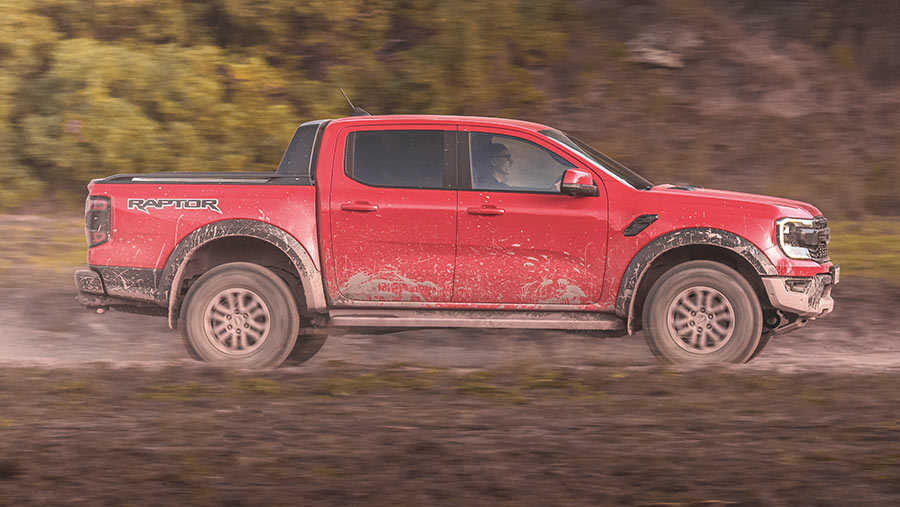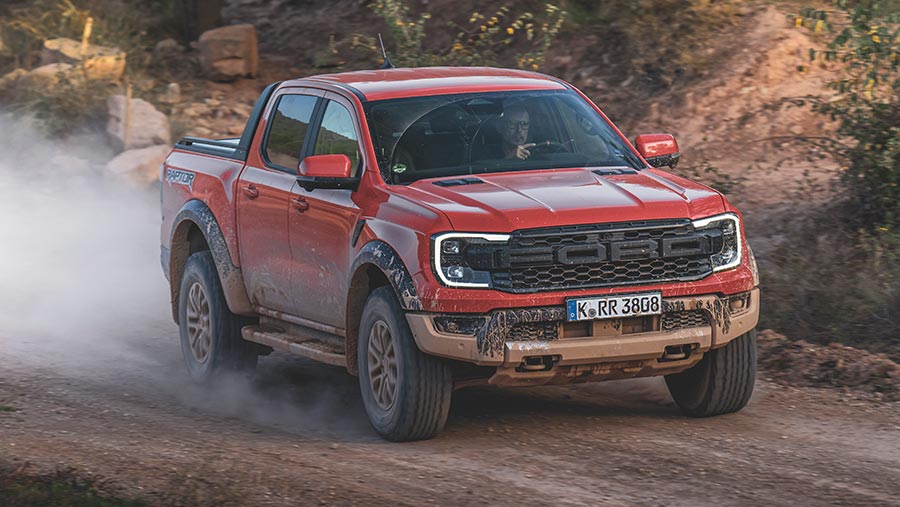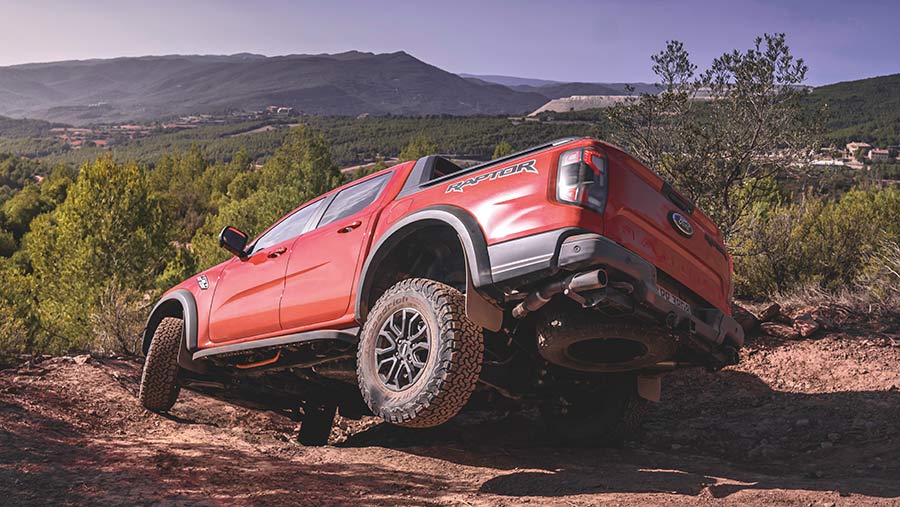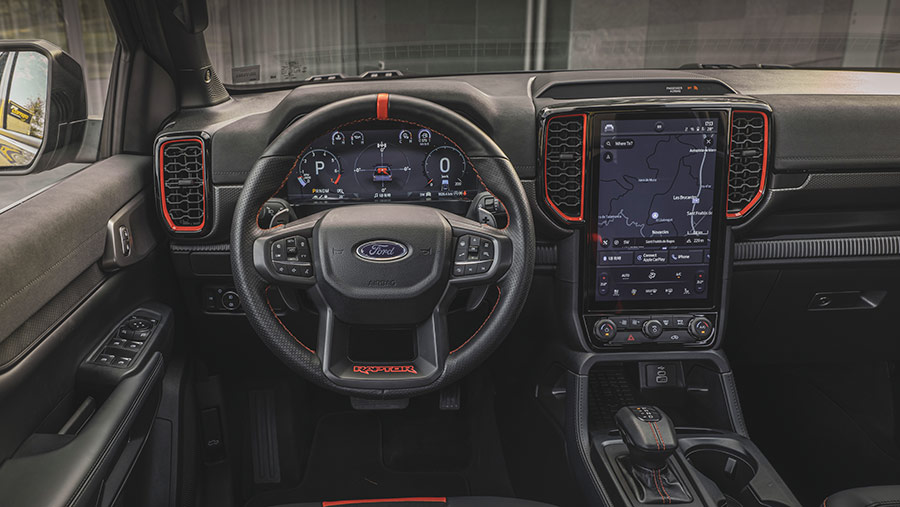First impressions: Ford’s new V6 Ranger Raptor pickup
 © Ford
© Ford Whisper it, but V6 engines are back in vogue – at least as far as Ford and Volkswagen’s pickups are concerned.
After years of depressing downsizing, initially to 2.7-litres, then 2.5-, 2.2- and comparatively wimpy 2-litre blocks, the Ranger and Amarok are relaunching in style with the return of torquey, twin-turbo six-potters.
In the case of the Raptor, the first of Ford’s new models to break cover, it is petrol-powered and tuned to serve up 491Nm.
That puts it just shy of the 500Nm available from the firm’s alternative engine option – a smaller and more economical 2-litre, four-cylinder turbodiesel.
See also: Pickup buyer’s guide 2022-23
But the V6 has the edge in the power stakes, with its 289hp contriving to make it the pokiest pickup available from mainstream UK dealerships.
That alone should justify the iconic Raptor name which, in the truck-loving US, is reserved for the F-150 Raptor – a 450hp menace powered by a 3.5-litre V6.
Ford Ranger Raptor
- Engine 3-litre, V6 petrol
- Power 289hp@5,500rpm
- Torque 491Nm@2,300rpm
- Transmission 10-speed automatic
- Max speed 111mph
- 0-62mph 7.9sec
- Combined consumption 20.4mpg (WLTP)
- Wheelbase 3,270mm
- Ground clearance 265mm
- Turning circle 13m
- Kerb weight 2,454kg
- Payload 652kg
- Towing capacity 2,500kg (braked)
- On the road price £57,960 (inc VAT)
Given our narrower roads and dearer fuel, this smaller, Euro-spec version feels like a decent compromise.
Nearly 300hp should be ample and it still gets a similar look to the macho US model with its C-shaped LED headlights and wide, in-yer-face F-O-R-D grille.
However, it’s by no means small. In fact, the latest iteration has grown 50mm wider to make room for the dampers fitted outside the vehicle’s ladder frame, to the benefit of performance.
Its wheelbase is longer too, by the same distance, to eke out a smidge more load space.
The biggest concession is the forfeiting of carrying capacity as a result of the Raptor’s fancier suspension system.
As before, comfort has taken precedence over its ability to do the donkey work.
While the new model has more space for carrying pallets, its payload is just 652kg – almost half that of the standard Ranger pickup – and the towing capacity set at a sub-par 2.5t.
The lack of payload will be a particular sore point, less so because of its physical limitations – most owners will carry little more than a hound or two, a box of tools or a couple of bags of feed – but mainly due to the impact it will have on the buyer’s pocket.
That’s because it’s well below the arbitrary 1t rating that determines whether or not it can be classified as a commercial vehicle. Unfortunately, that means businesses won’t be able to claim the VAT back on the £57,960 price.
If you can stomach that then there’s plenty to like…
Solid build

© Ford
Surprisingly, given the cost of the truck relative to the profitability of most farm commodities, farmers are actually said to be one of the target markets for the Raptor, which was designed in Australia by Ford’s Performance arm.
Demand there is huge, both for flatbed “utes” – a staple down under – and larger 1t pickups such as the Ranger and Toyota Hilux, and Ford has endeavoured to bring the benefits of both vehicle types to the Raptor.
On outback farms covering millions of acres, in one of the harshest environments on the planet, a Ranger Raptor is apparently the ideal tool because, says Ford, it has been engineered to cope with pretty much anything thrown at it.
The graphite-iron cylinder block is reckoned to be 75% stronger and stiffer than the iron used in a regular engine and the 2.3mm steel bash plate below is nearly twice as thick as before.
But the Raptor’s real strengths lie in its suspension, with the first-gen model’s Fox racing shocks upgraded to clever 2.5in-wide “live valve” dampers.
These automatically adjust the pressure on the spring behind the main shock valve, based on information provided by sensors on each suspension unit, the driving style, and throttle and steering input.
The end result is a greater range of vertical travel and improved compression damping that, as we found, delivers a far smoother ride.
While the old model’s suspension was impressive, and improved with speed, it did tend to suffer from occasional bouts of front-end bounce.
That fidgety habit has now been stifled, resulting in a level of refinement almost akin to a luxury car.
The handling is precise, and the steering faster and sharper, making a big, heavy truck feel oddly dynamic, in a tap-dancing elephant kind of way.
Off-road upgrades

© Ford
Performance has also been improved on the worst terra firma has to offer.
Seven selectable driving modes are available via a rotary dial that resides in the shadow of the newly designed e-shifter gear selector – itself used to control the 10-speed automatic transmission with two-speed transfer case.
Driving modes include normal, sport and slippery, plus rock crawl, mud/ruts, sand and “Baja”.
Each setting activates a different profile, altering various parameters including the amount of traction control, gear shift speed and even the exhaust note.
The permanent four-wheel-drive system gets low range gears and there are front and rear diff-locks as standard, giving the Raptor unprecedented mechanical abilities.
It also has a formidable 32deg approach angle, 27deg on the departure (though it drops to 24deg with a towbar) and a 24deg break-over angle.
The goodies
There are plenty of gimmicks too, not least the aforementioned electronically baffled performance exhaust with adjustable settings – quiet, normal, sport and “Baja”.
The latter effectively transforms the system into straight-through pipes, and the resulting sound is quite glorious.

© Ford
A 12in portrait touchscreen is the interior’s main party piece, functioning not only as the navigation and infotainment system but also as the heart of the dynamic controls for off-roading.
It’s here that the differentials can be activated and the new “trail control” feature engaged.
This works as an alternative cruise control for off-roading at speeds as low as 1mph and over all terrain types, including when descending a hill – simply set the speed, take your feet off both pedals and concentrate on the steering.
It makes challenging off-roading much easier by providing a constant amount of throttle to maintain momentum.
Elsewhere, the upmarket interior, with its “code red” coloured accents around the air vents, on the seats and stitched into the steering wheel, single it out as a cut above the average pickup.
Likes and gripes
Likes
✔ Decent off-road
✔ Exceptional ride quality
✔ Raucous V6
Gripes
✘ Poor payload
✘ No VAT exemption
✘ Not as fast as it could be
Farmers Weekly verdict
The Ranger Raptor is a comfortable and capable truck – it’s more versatile than a Land Rover Defender Hardtop and maybe even a credible alternative to a full spec Range Rover, at half the price.
It’s also a lot faster, more desirable and fun than the Ranger Wildtrak – the penalty being a higher upfront cost and a hefty payment to the taxman.
